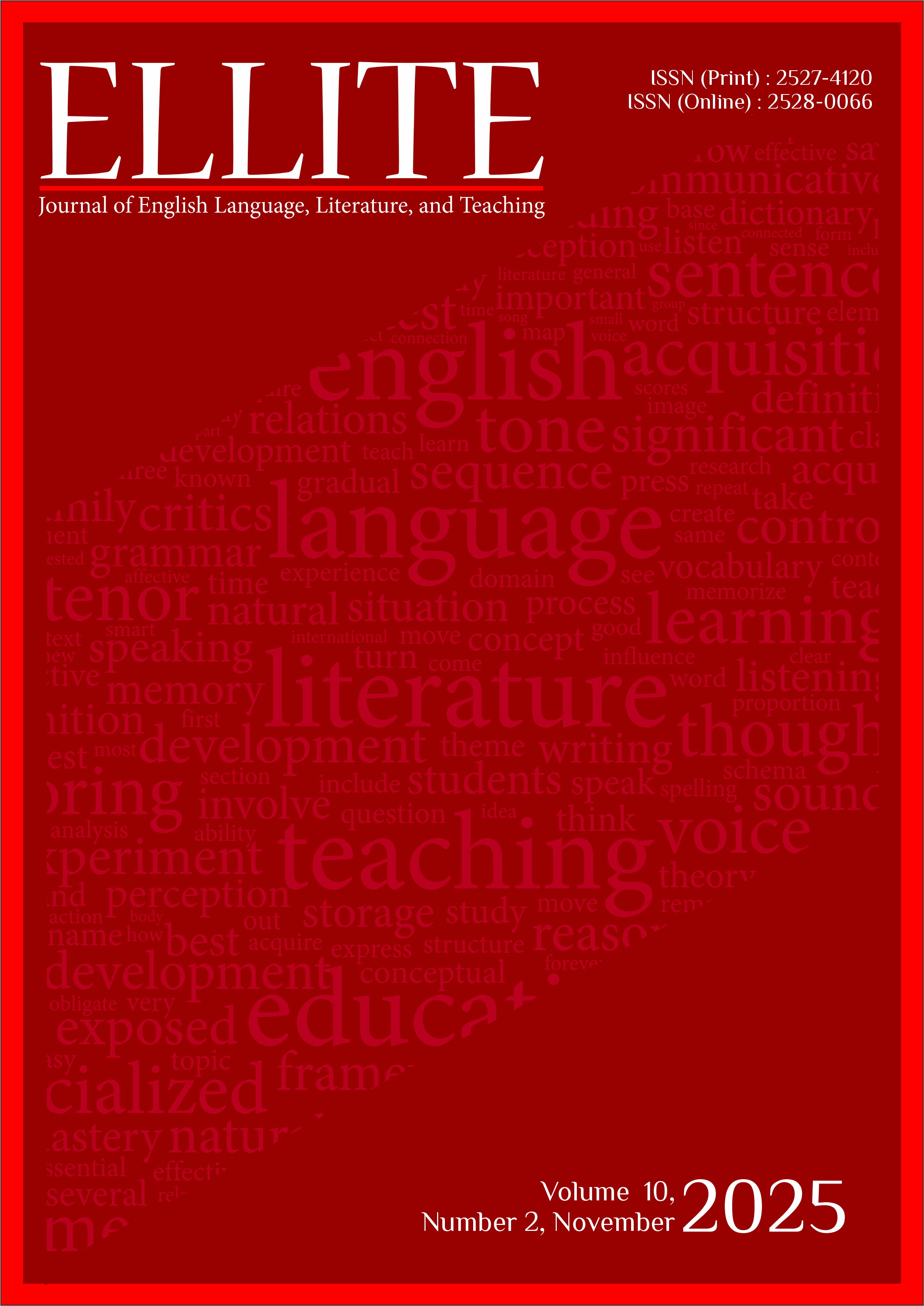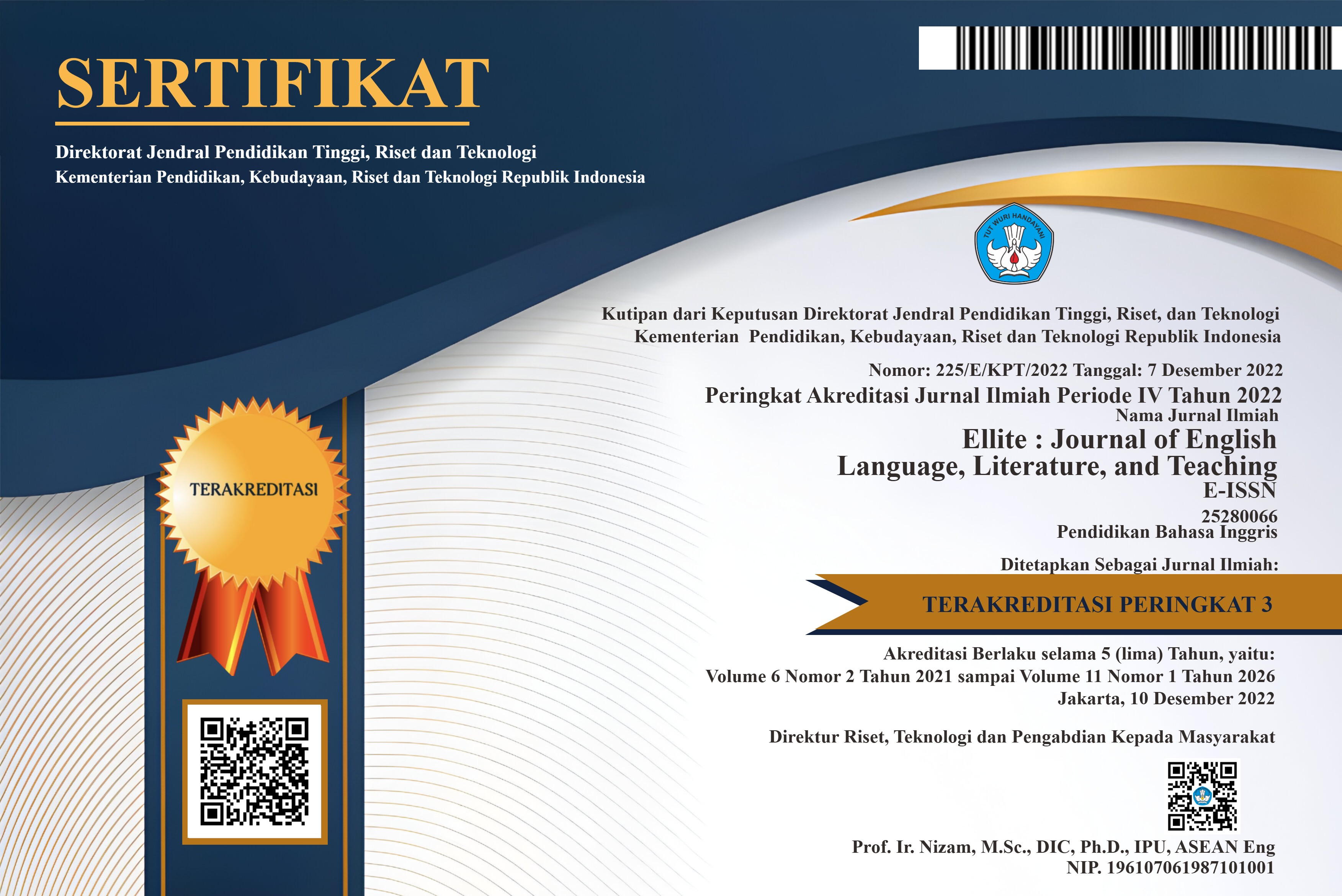The Interplay of Semantics, Pragmatics, and Digital Identity in Social Media Discourse: An Analysis of #JulidFisabilillah
DOI:
https://doi.org/10.32528/ellite.v10i2.3867Keywords:
Virtual Communication, Semantics and Pragmatics, Social Media, Digital IdentityAbstract
This study investigates the intricate relationship between semantics and pragmatics within the realm of virtual communication, with a particular emphasis on social media interactions. It explores how the meanings of words and phrases (semantics), in conjunction with the contextual factors surrounding their use (pragmatics), play a crucial role in shaping digital identity and fostering online community formation. The research reveals that language on social media functions not merely as a medium of information exchange but also as a vehicle for conveying emotions, attitudes, and opinions. Specific lexical choices and symbolic elements are shown to signify group affiliation and ideological positioning. The case study of the hashtag #JulidFisabilillah on Twitter exemplifies these phenomena, illustrating how hashtags can serve both as markers of collective identity and as reflections of broader socio,cultural discourses. Ultimately, the findings underscore that effective analysis of social media communication must extend beyond literal content to include consideration of contextual factors. This research contributes to a deeper understanding of digital discourse by foregrounding the interplay of semantics, pragmatics, and context in the construction of meaning and identity in online spaces
References
Anggraini, M. (2023). An Analysis of Directive Illocutionary Speech Acts in “Luca” Movie: Pragmatic Approach. Prodi Sastra Inggris.
Arfianti, I. (2020). Pragmatik: Teori dan Analisis (Buku Ajar). CV. Pilar Nusantara.
Arroyo,Machado, W., Torres,Salinas, D., & Robinson,Garcia, N. (2021). Identifying and characterizing social media communities: a socio, semantic network approach to altmetrics. Scientometrics, 126(11), 9267–9289.
Aull, B. (2019). A study of phatic emoji use<? br?> in WhatsApp communication. Internet Pragmatics, 2(2), 206–232.
Azmah, S. F. N. (2020). Analisis argumentasi dalam wacana kampanye PILPRES 2019 pada media sosial Twitter. Jakarta: FITK UIN Syarif Hidayatullah Jakarta.
Bai, Q., Dan, Q., Mu, Z., & Yang, M. (2019). A systematic review of emoji: Current research and future perspectives. Frontiers in Psychology, 10, 2221.
Benamara, F., Inkpen, D., & Taboada, M. (2018). Introduction to the Special Issue on Language in Social Media: Exploiting Discourse and Other Contextual Information. Computational Linguistics, 44(4), 663–681. https://doi.org/10.1162/coli_a_00333
Besman, A. (2014). Pencitraan visionary hero di masa kampanye dalam media sosial twitter. Masters thesis, Universitas Islam Bandung.
Bruzzese, S., Ahmed, W., Blanc, S., & Brun, F. (2022). Ecosystem services: a social and semantic network analysis of public opinion on Twitter. International Journal of Environmental Research and Public Health, 19(22), 15012.
Bungin, B. (2009). Pemahaman Filosofis dan Metodologis Kearah Penguasaan Model Aplikasi Cet. III. Jakarta: Rajawali Press.
Burhan, B. (2010). Metodologi Penelitian Kualitatif. Raja Grafindo Persada.
Chung, S.,F., & Liu, H.,W. (2023). The pragmatics of social media: Introduction. International Review of Pragmatics, 15(2), 165–167. https://doi.org/https://doi.org/10.1163/18773109,01502001
Cutting, J., & Fordyce, K. (2020). Pragmatics: a resource book for students. Routledge.
Dejica, D., Hansen, G., Sandrini, P., & Para, I. (2016). Language in the Digital Era. Challenges and Perspectives.
Dridi, A., & Reforgiato Recupero, D. (2019). Leveraging semantics for sentiment polarity detection in social media. International Journal of Machine Learning and Cybernetics, 10, 2045–2055.
Dwijatmoko, B. B. (2018). Penelitian Korpus: Kajian Bahasa dan Metodologi. KONGRES INTERNASIONAL MASYARAKAT LINGUISTIK INDONESIA (KIMLI) 2018, 16.
Eke, C. I. (2021). Multi,Feature Fusion Framework for Automatic Sarcasm Identification in Twitter Data. University of Malaya (Malaysia).
Ferrara, E. (2020). 378Dynamics of Attention and Public Opinion in Social Media. In B. Foucault Welles & S. González,Bailón (Eds.), The Oxford Handbook of Networked Communication (p. 0). Oxford University Press. https://doi.org/10.1093/oxfordhb/9780190460518.013.21
Gawne, L., & McCulloch, G. (2019). Emoji as digital gestures. Language@ Internet, 17(2).
Gruber, H. (2019). Genres, media, and recontextualization practices: Re,considering basic concepts of genre theory<? br?> in the age of social media. Internet Pragmatics, 2(1), 54–82.
Hoehle, H., Zhang, X., & Venkatesh, V. (2015). An espoused cultural perspective to understand continued intention to use mobile applications: a four,country study of mobile social media application usability. European Journal of Information Systems, 24(3), 337–359.
Kristani, K. (2012). An Analysis of Directive Speech Acts in the Movie “Sleeping Beauty.” Final Project. Binus University Jakarta: Unpublished.
Levinson, S. C. (2017). 199Speech Acts. In Y. Huang (Ed.), The Oxford Handbook of Pragmatics (p. 0). Oxford University Press. https://doi.org/10.1093/oxfordhb/9780199697960.013.22
Ludwig, S., & de Ruyter, K. (2016). Decoding social media speak: developing a speech act theory research agenda. Journal of Consumer Marketing, 33(2), 124–134.
Mabaquiao Jr, N. M. (2018). Speech Act Theory: From Austin to Searle. Augustinian Journal, 19(1), 1–18.
Nadali, S. (2016). SARCASM DETECTION MODEL BASED ON TWEETS’STRENGTH USING HASHTAGS AND NON,HASHTAGS SENTIMENT ANALYSIS. Philosophy.
Nasarudin, N., Susanti, S., Akmal, A., Razak, N. K., Annisa, A., Herman, H., Manurung, L. W., Arianto, T., Putri, F. R., & Saragi, C. N. (2023). Pragmatik: Konsep Teori dan Praktek. CV. Gita Lentera.
Nemer, D. (2015). Celebrities acting up: a speech act analysis in tweets of famous people. Social Networking, 5(1), 1–10.
Paulina, M. B. (2015). Kampanye Hitam Calon Presiden Republik Indonesia dalam Pemilihan Presiden 2014: Sebuah Kajian Pragmatik. Universitas Pendidikan Indonesia.
Radicioni, T., Saracco, F., Pavan, E., & Squartini, T. (2021). Analysing Twitter semantic networks: the case of 2018 Italian elections. Scientific Reports, 11(1), 13207.
Reyes, A. (2018). Virtual communities: Interaction, identity and authority in digital communication. Text & Talk, 39(1), 99–120.
Romdhoni, A. (2019). Semiotik Metodologi Penelitian. Literatur Nusantara.
Sawaki, Y. W. (2023). Istilah Toponimi Tabui dan Humli pada Masyarakat Yali di Papua: Sebuah Kajian Semantik dan Pragmatik. Linguistik Indonesia, 41(2), 223–240.
Setiawati, E., & Arista, H. D. (2018). Piranti pemahaman komunikasi dalam wacana interaksional: Kajian pragmatik. Universitas Brawijaya Press.
Simanjuntak, F., Hasanah, N., Ariffendi, J., Lilis, L., Clarissa, N., Kalalo, P. A., Richad, R., & Angelika, P. (2022). Penggunaan Internet Kalangan Pemuda Dalam Aksi Bullying Dan Hate Speech. The National Conference for Community Service Project (NaCosPro), 4(1), 328–335. https://doi.org/10.37253/NACOSPRO.V4I1.6967
Stalnaker, R. (2018). 384Dynamic Pragmatics, Static Semantics. In D. Fogal, D. W. Harris, & M. Moss (Eds.), New Work on Speech Acts (p. 0). Oxford University Press. https://doi.org/10.1093/oso/9780198738831.003.0014
Sudaryanto, S., Said, R., & Kurniawati, A. C. (n.d.). Tagar sebagai Sarana Berbahasa Partai Politik: Kajian Pragmatika atas Wacana Kampanye Pemilihan Umum 2019. Kode: Jurnal Bahasa, 8(4).
Wagiati, W., Darmayanti, N., & Adji, M. (2023). Dinamika Linguistik Penggunaan Emotikon dan Emoji dalam Wacana Termediasi Komputer: Studi Kasus pada Pengguna Sosial Media di Indonesia. Diglosia: Jurnal Pendidikan, Kebahasaan, Dan Kesusastraan Indonesia, 7(2).
Watie, E. D. S. (2016). Komunikasi dan Media Sosial (Communications and Social Media). Jurnal The Messenger, 3(2), 69. https://doi.org/10.26623/themessenger.v3i2.270
Yin, R. K. (2002). Studi Kasus: Desain dan Metode. Raja Grafindo Persada.
Yuna, D., Xiaokun, L., Jianing, L., & Lu, H. (2022). Cross,Cultural Communication on Social Media: Review From the Perspective of Cultural Psychology and Neuroscience . In Frontiers in Psychology (Vol. 13). https://www.frontiersin.org/articles/10.3389/fpsyg.2022.858900
Downloads
Published
Issue
Section
Categories
License
Copyright (c) 2025 Agung Olaf Ridho Rambe, Mulyadi Mulyadi

This work is licensed under a Creative Commons Attribution 4.0 International License.







